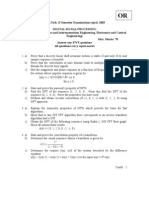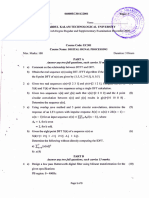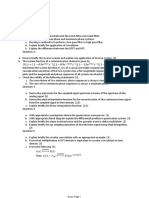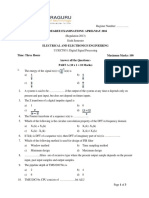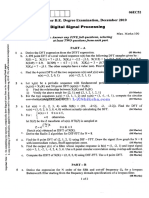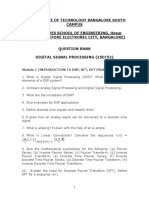Model Question Paper
Model Question Paper
Uploaded by
Darshan BilgiCopyright:
Available Formats
Model Question Paper
Model Question Paper
Uploaded by
Darshan BilgiOriginal Description:
Original Title
Copyright
Available Formats
Share this document
Did you find this document useful?
Is this content inappropriate?
Copyright:
Available Formats
Model Question Paper
Model Question Paper
Uploaded by
Darshan BilgiCopyright:
Available Formats
15EC52
Visvesvaraya Technological University, Belagavi
MODEL QUESTION PAPER
5th Semester, B.E (CBCS) EC/TC
Course: 15EC52 - Digital Signal processing
Time: 3 Hours Max Marks: 80
Note: (i) Answer Five full questions selecting any one full question from each Module.
(ii) Question on a topic of a Module may appear in either its 1st or 2nd question.
Module 1
1 (a) Explain the frequency domain sampling and reconstruction of discrete time signals. 8
(b) The first five points of the eight point DFT of a real valued sequence are 3
{0.25, 0.125-j0.3018, 0, 0.125-j0.0518, 0}. Determine the remaining three points.
(c) Determine the circular convolution of the sequences, x1(n) = {1,2,3,1}, 5
x2(n)={4,3,2,2} using time domain approach.
OR
2 (a) Obtain the relationship of DFT with the Z-transform. 5
(b) Show that the multiplication of two DFTs leads to circular convolution of respective 7
time sequences.
(c) Consider a finite duration sequence x(n) = {0,1,2,3,4}. 4
(i) Determine the sequence y(n) with six point DFT Y(k) = Real[X(k)]
(ii) Determine the sequence v(n) with six point DFT V(k) = Imaginary[X(k)]
Module 2
3 (a) Explain the linear filtering of long data sequences using overlap-save method. 6
(b) The 4-point DFT of a real sequence x(n) is X(k) = (1, j, 1, -j). Find the DFTs of the 6
following.
i) x1(n) = (-1)nx(n),
ii) ii) x2(n)=x((n+1))4,
iii) iii) x3(n) = x(4-n)
(c) Explain the computational complexity of direct computation of DFT. What are the 4
efficient algorithms for the evaluation of the DFT?
OR
4 (a) Find the response of an LTI system with an impulse response h(n) = (3,2,1) for the 7
input x(n) = (2, -1, -1, -2, -3, 5,6,-1, 2,0,2,1) using overlap and add method. Use 8
point circular convolution.
(b) The 5-p0int DFT of a complex sequence x(n) is X(k)=(j, 1+j, 1+j2, 4+j). Compute Y(k), if 4
y(n)=x*(n).
(c) State and prove the property of circular time shift of a sequence. 5
Module 3
5 (a) Derive the radix-2 decimation in time FFT algorithm and draw the signal flow graph 8
for eight point DFT computation.
(b) Find the number of complex additions and complex multiplications required for 128- 3
point DFT computation using i) Direct method, ii) FFT method. What is the speed
improvement factor?
(c) Find the 4-point real sequence x(n), if its DFT samples are X(0)=6, X(1)=-2+j2, X(2)=-2. 5
Use DIF-FFT algorithm.
OR
6 (a) Compute the eight point DFT of the sequence x(n) = { ½, ½, ½, ½, 0,0,0,0} using the 8
inplace radix-2 decimation in frequency FFT algorithm.
(b) Explain the Goertzel algorithm and obtain the direct form II realization. 8
Module 4
7 (a) 5
Obtain the cascade realization for a system described by H(z) = .
(b) Explain the design of IIR filter by Impulse invariance technique. 6
(c) Determine the order and cut off frequency of Butterworth analog highpass filter to 5
meet the specifications: Maximum passband attenuation = 2 dB, Minimum stop band
attenuation = 20 dB, Passband edge frequency = 200 rad/sec, stopband edge
frequency = 100 rad/sec.
OR
8 (a) Obtain the parallel realization of the system function H(z) = 6
(b) Design a digital low pas Butterworth filter using bilinear transformation to meet the 6
specifications: i) -3 dB cut-off frequency at 0.5 π rad, ii) -15 dB at 0.75π rad. Obtain
H(Z) assuming T=1 sec.
(c) What are the characteristics of Chebyshev filters? Define its magnitude response and 4
list the properties of polynomial for type I Chebyshev filters.
Module 5
9 (a) Realize the linear phase FIR filter for the impulse response 3
h(n)= (n)+ ¼ (n-1)- ½(n-1)+ ¼ (n-3)+ (n-4) using direct form.
(b) Describe the frequency sampling realization of FIR filter. 7
(c) Determine the filter coefficients of an FIR filter for the desired frequency response 6
Hd(ω)
Use rectangular window function. Find the frequency response H(ω) of the filter.
OR
10 (a) Consider an FIR lattice filter with coefficients K1=0.65, K2=-0.34 and K3=0.8. Find its 7
impulse response and draw the direct form structure.
(b) Determine the impulse response of an FIR filter to meet the specifications: Passband 6
edge frequency of 1.5 KHz, Stopband edge frequency of 2 KHz, Sampling frequency
of 8 KHz. Use the Hamming window function.
(c) Compare the different window functions used in FIR filter design. 3
You might also like
- DSP Nec-011 - 1Document3 pagesDSP Nec-011 - 1Chhaya GroverNo ratings yet
- Ec301 Digital Signal Processing, December 2023Document2 pagesEc301 Digital Signal Processing, December 2023sandraNo ratings yet
- AC Questions PaperDocument2 pagesAC Questions Papernareddy vinay kumar reddyNo ratings yet
- Question Paper Code:: (10×2 20 Marks)Document3 pagesQuestion Paper Code:: (10×2 20 Marks)ManimegalaiNo ratings yet
- Ect303 Digital Signal Processing, December 2023Document3 pagesEct303 Digital Signal Processing, December 2023ec2228No ratings yet
- EE61 June 2010Document2 pagesEE61 June 2010MSGNo ratings yet
- Or-421051 - Digital Signal ProcessingDocument2 pagesOr-421051 - Digital Signal ProcessingSrinivasa Rao GNo ratings yet
- 07a51101 Digital Signal ProcessingDocument8 pages07a51101 Digital Signal ProcessingSRINIVASA RAO GANTANo ratings yet
- Ec301 Digital Signal Processing, December 2020Document3 pagesEc301 Digital Signal Processing, December 2020sandraNo ratings yet
- Ec301 Digital Signal Processing, January 2023Document2 pagesEc301 Digital Signal Processing, January 2023sandraNo ratings yet
- Assignment For B.Tech ECE: X N X KDocument3 pagesAssignment For B.Tech ECE: X N X KTanmay GoelNo ratings yet
- National Institute of Technology RourkelaDocument2 pagesNational Institute of Technology Rourkelapradhansibasankar10No ratings yet
- Answer Any Two Full Questions, Each Carries 15 Marks: Reg No.: - NameDocument2 pagesAnswer Any Two Full Questions, Each Carries 15 Marks: Reg No.: - NameGjNo ratings yet
- QB - Pattern CATDocument9 pagesQB - Pattern CATakalan803No ratings yet
- C F1048 Pages:2: Answer Any Two Full Questions, Each Carries 15 MarksDocument2 pagesC F1048 Pages:2: Answer Any Two Full Questions, Each Carries 15 MarksGlan DevadhasNo ratings yet
- DSP 2020Document3 pagesDSP 2020nbg2006No ratings yet
- JNTU Old Question Papers 2007Document8 pagesJNTU Old Question Papers 2007Srinivasa Rao G100% (1)
- DSPDocument12 pagesDSPAshish Chandrakant ChavanNo ratings yet
- Model Exam DSPDocument2 pagesModel Exam DSPChristoNo ratings yet
- Adobe Scan 12-Mar-2024Document7 pagesAdobe Scan 12-Mar-2024suhagajakesavaNo ratings yet
- Indian Institute of Information Technology Tiruchirappalli Department of Electronics & Communication EngineeringDocument3 pagesIndian Institute of Information Technology Tiruchirappalli Department of Electronics & Communication EngineeringParamesh WaranNo ratings yet
- EC3601 (1) - MergedDocument5 pagesEC3601 (1) - MergedRobin KumarNo ratings yet
- NR-311102 - Digital Signal ProcessingDocument8 pagesNR-311102 - Digital Signal ProcessingSrinivasa Rao GNo ratings yet
- r05320201 Digital Signal ProcessingDocument8 pagesr05320201 Digital Signal ProcessingSRINIVASA RAO GANTANo ratings yet
- Model Question Paper - With Effect From 2020-21 (CBCS Scheme)Document4 pagesModel Question Paper - With Effect From 2020-21 (CBCS Scheme)Devankit SanuNo ratings yet
- Bapatla Engineering College::Bapatla: k δ (n−k) - π n) sin Document4 pagesBapatla Engineering College::Bapatla: k δ (n−k) - π n) sin KURRA UPENDRA CHOWDARY0% (1)
- Set No: 1: Code: V3218/R07 Digital Signal Processing Time: 3 Hours Max. Marks: 80Document4 pagesSet No: 1: Code: V3218/R07 Digital Signal Processing Time: 3 Hours Max. Marks: 80Manam Sundeep YadavNo ratings yet
- Be Winter 2020Document2 pagesBe Winter 2020Suraj ThakurNo ratings yet
- B.E Degree Examinations: April/May 2016Document3 pagesB.E Degree Examinations: April/May 2016PRAVEEN O.KNo ratings yet
- Rr410201 Digital Signal ProcessingDocument8 pagesRr410201 Digital Signal ProcessingRohan GaonkarNo ratings yet
- EE414 DSP - Final Exam - Jan 2021 - Set ADocument9 pagesEE414 DSP - Final Exam - Jan 2021 - Set ASalman YusufNo ratings yet
- DSP QuestionsDocument8 pagesDSP Questionsjjshree79No ratings yet
- Signals and Systems EC S4 B.Tech KTU 2017Document2 pagesSignals and Systems EC S4 B.Tech KTU 2017ShemsNo ratings yet
- 20A04502T Digital Signal ProcessingDocument2 pages20A04502T Digital Signal ProcessingShaik AlthafNo ratings yet
- Gujarat Technological UniversityDocument2 pagesGujarat Technological UniversityTushar MaruNo ratings yet
- Ec301 Digital Signal Processing June 2024Document2 pagesEc301 Digital Signal Processing June 2024sandraNo ratings yet
- Seventh Semester B. Tech. Degree Examination: (Answer All Questions: 5 X 2 Marks 10 Marks)Document2 pagesSeventh Semester B. Tech. Degree Examination: (Answer All Questions: 5 X 2 Marks 10 Marks)Gīřïşh McNo ratings yet
- Ec301 Digital Signal Processing, January 2022Document2 pagesEc301 Digital Signal Processing, January 2022sandraNo ratings yet
- Shirdi Sai Engg CollegeDocument12 pagesShirdi Sai Engg CollegeSGSNo ratings yet
- Question Bank DSP EEC-602Document3 pagesQuestion Bank DSP EEC-602Sougata GhoshNo ratings yet
- EET453 Digital Signal ProcessingDocument9 pagesEET453 Digital Signal ProcessingManjesh ManojNo ratings yet
- DSP ExamDocument2 pagesDSP ExamS. MagidiNo ratings yet
- III Year - Electronics and Communication Engineering Ec 6502 - Principles of Digital Signal ProcessingDocument8 pagesIII Year - Electronics and Communication Engineering Ec 6502 - Principles of Digital Signal ProcessingYokesvaran KNo ratings yet
- DSP QPDocument54 pagesDSP QPParamesh WaranNo ratings yet
- DSP 5Document2 pagesDSP 5Suman RoyNo ratings yet
- 2008 Regulations Question PaperDocument15 pages2008 Regulations Question PaperSivabalanNo ratings yet
- Code - No: 07A6EC01: HN Eun HT e Btut HT Te Ut HN e UnDocument8 pagesCode - No: 07A6EC01: HN Eun HT e Btut HT Te Ut HN e UnSai SivaNo ratings yet
- NR 410201 Digital Signal ProcessingDocument8 pagesNR 410201 Digital Signal ProcessingSrinivasa Rao GNo ratings yet
- DSP QBDocument7 pagesDSP QBRoopa Nayak100% (1)
- r05320201 Digital Signal ProcessingDocument8 pagesr05320201 Digital Signal ProcessingBharath LudiNo ratings yet
- DSP QBDocument4 pagesDSP QBakhila pemmarajuNo ratings yet
- DTSPDocument4 pagesDTSPmonisa kannanNo ratings yet
- Digital Signal Processing Sessional Paper PDFDocument1 pageDigital Signal Processing Sessional Paper PDFAshish NautiyalNo ratings yet
- Discrete Fourier Analysis and Wavelets: Applications to Signal and Image ProcessingFrom EverandDiscrete Fourier Analysis and Wavelets: Applications to Signal and Image ProcessingNo ratings yet
- Discrete Wavelet Transform: A Signal Processing ApproachFrom EverandDiscrete Wavelet Transform: A Signal Processing ApproachRating: 5 out of 5 stars5/5 (2)
- On the Tangent Space to the Space of Algebraic Cycles on a Smooth Algebraic VarietyFrom EverandOn the Tangent Space to the Space of Algebraic Cycles on a Smooth Algebraic VarietyNo ratings yet
- Chipless Radio Frequency Identification Reader Signal ProcessingFrom EverandChipless Radio Frequency Identification Reader Signal ProcessingNo ratings yet
- All Pass Filter DesignDocument2 pagesAll Pass Filter Designnivia25No ratings yet
- Bessel Filter PDFDocument3 pagesBessel Filter PDFERIKA ARIASNo ratings yet
- Band Pass Filter Design Part 8. Band Pass Filters From First Principles Richard Harris G3OTKDocument5 pagesBand Pass Filter Design Part 8. Band Pass Filters From First Principles Richard Harris G3OTKopachecoNo ratings yet
- IF Filters: General Filter Theory: Q Is The Quality Factor of The Filter F B Is The - 3 DB Bandwidth of The FilterDocument11 pagesIF Filters: General Filter Theory: Q Is The Quality Factor of The Filter F B Is The - 3 DB Bandwidth of The FilterDragan IvanovNo ratings yet
- Design and Implementation of IIR FilterDocument45 pagesDesign and Implementation of IIR FilterSaurabh Shukla67% (3)
- Network and SynthesisDocument22 pagesNetwork and SynthesisERMIAS AmanuelNo ratings yet
- N DSP6Document10 pagesN DSP6sadhanatiruNo ratings yet
- Problem 6.24 (A) (B) (C) : SolutionDocument2 pagesProblem 6.24 (A) (B) (C) : Solutionali ahmedNo ratings yet
- 9781107059320-SOLUTIONS Essential Digital SolutionsDocument47 pages9781107059320-SOLUTIONS Essential Digital SolutionsGulrez MNo ratings yet
- Revision Bode 1Document5 pagesRevision Bode 1Lee Jia QiNo ratings yet
- Smoothing and SharpeningDocument10 pagesSmoothing and SharpeningPRASHANTHI B (RA2133013011003)No ratings yet
- Assignment 2 - FIRDocument3 pagesAssignment 2 - FIRSanthoshi KNo ratings yet
- CPEN 304 L08 - 1 - FIR Filter Design 2Document47 pagesCPEN 304 L08 - 1 - FIR Filter Design 2Phoebe MensahNo ratings yet
- Pee 40 QueDocument6 pagesPee 40 QueBnr GoudNo ratings yet
- Ch7 Digital Filter DesignDocument37 pagesCh7 Digital Filter DesignAemal KhanNo ratings yet
- Lab Report FinalDocument23 pagesLab Report FinalSampath ReddyNo ratings yet
- Chapter-3 Adsp: Digital Filter StructuresDocument42 pagesChapter-3 Adsp: Digital Filter Structureshusiyyoo mustefaNo ratings yet
- کتاب پراهمیت فقط برای دانلودDocument1 pageکتاب پراهمیت فقط برای دانلودzzzxxccvvvNo ratings yet
- 09 Chapter 3Document44 pages09 Chapter 3Amisha kambleNo ratings yet
- Maximally-Flat Filters in Waveguide PDFDocument30 pagesMaximally-Flat Filters in Waveguide PDFagmnm1962No ratings yet
- Heiken Profit Normal BacktestDocument4 pagesHeiken Profit Normal Backtestbicolorfifeiro88No ratings yet
- DSP Quiz Assignment ProbSolving CE2 UploadDocument5 pagesDSP Quiz Assignment ProbSolving CE2 UploadANo ratings yet
- Frequency Domain Filtering Image ProcessingDocument24 pagesFrequency Domain Filtering Image ProcessingSankalp_Kallakur_402100% (1)
- Butterworth FilterDocument6 pagesButterworth FilterSatish KumarNo ratings yet
- CET4910 Lab7Document2 pagesCET4910 Lab7Sawera ZahraNo ratings yet
- Cohn, S.B.Document9 pagesCohn, S.B.Hari VarmaNo ratings yet
- Lecture 31: Filter Implementation: 1 ELEC4630, Shu Yang, HKUSTDocument18 pagesLecture 31: Filter Implementation: 1 ELEC4630, Shu Yang, HKUSTAlejandro GudiñoNo ratings yet
- Analogue MatlabDocument10 pagesAnalogue MatlabIAMMARKSNo ratings yet
- Digital Signal Processing Dec2021Document2 pagesDigital Signal Processing Dec2021adith t mNo ratings yet
- EMJ22204-Chapter 3 - Active FiltersDocument76 pagesEMJ22204-Chapter 3 - Active FiltersMUHAMMAD ZAFRI BIN ZAINI STUDENTNo ratings yet






